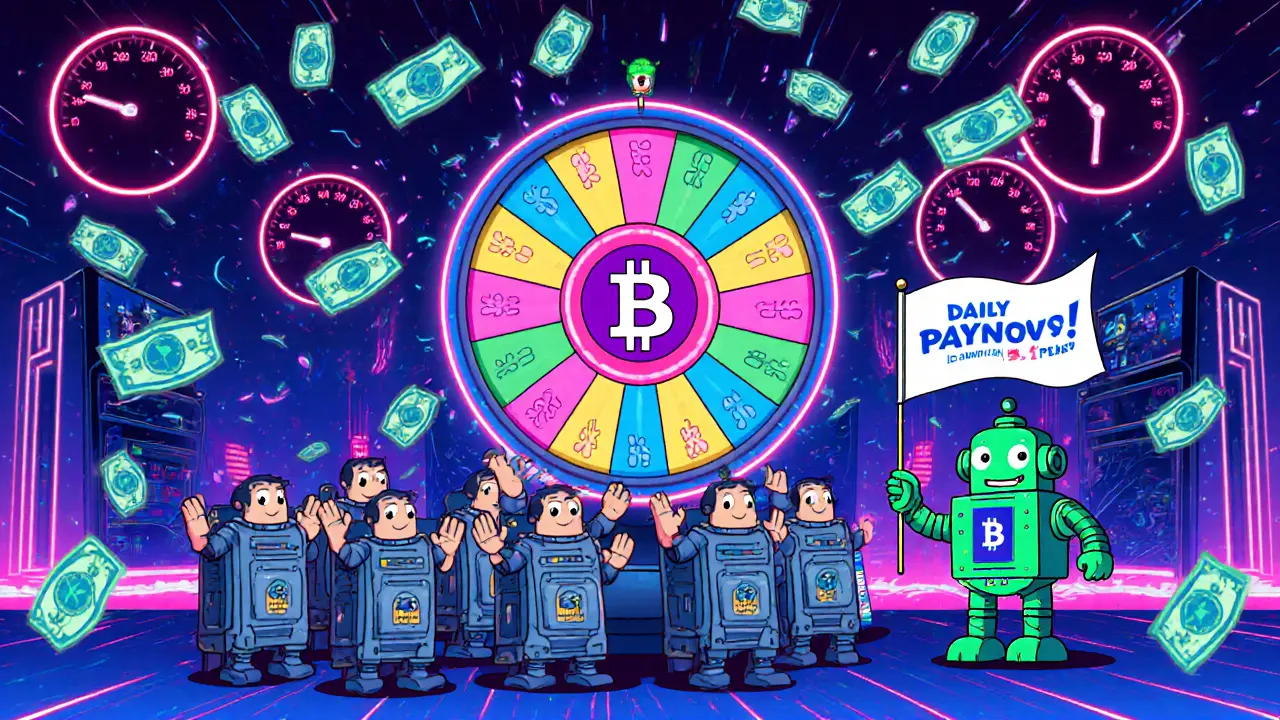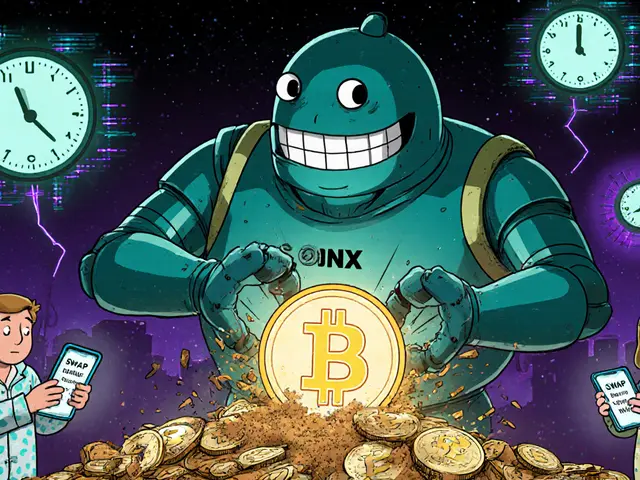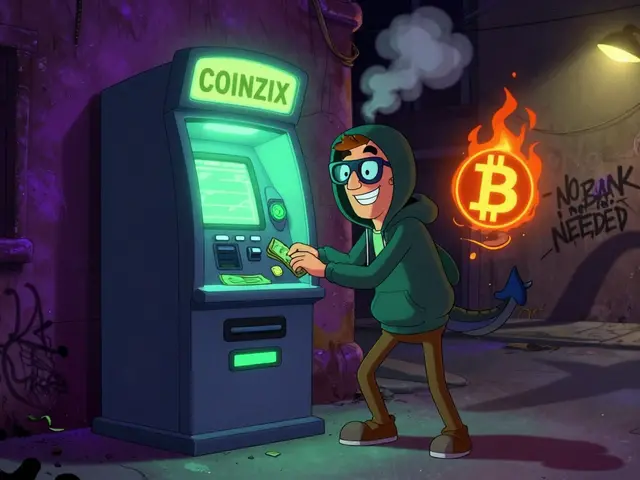Bitcoin Mining Earnings Calculator
Calculate Your Mining Earnings
Enter your total hash rate (e.g., 100 TH/s for a single Antminer S19)
Solo Mining (High Risk)
Based on article data for 2025 network conditions
Only viable for operations over 1 EH/s (1,000,000 TH/s)
Pool Mining (Stable)
Based on article data for 2025 network conditions
Recommended for all individual miners
Key Insight: With 100 TH/s (a single Antminer S19), pool mining generates $12.50/day while solo mining yields $95.89/day on average but with high risk and uncertainty.
Back in 2009, mining Bitcoin was something you could do on your home computer. A single CPU could find a block now and then. Today, that’s impossible. The network’s difficulty has skyrocketed by over 4,300% since 2020. If you’re mining Bitcoin now, you’re either part of a group-or you’ve got a warehouse full of ASICs. This isn’t just about technology anymore. It’s about economics, patience, and risk tolerance. So, which path makes sense for you: solo mining or pool mining?
What Solo Mining Really Means
Solo mining means you’re alone. No helpers. No partners. You run a full Bitcoin node, connect your ASICs directly to the blockchain, and try to solve the next block by yourself. If you win, you get the entire 3.125 BTC block reward plus all the transaction fees. No one else gets a cut. Sounds great, right? But here’s the catch: you’re competing against the entire Bitcoin network, which currently has a hash rate of over 600 exahashes per second (EH/s). To have even a 50% chance of finding a block in a year, you’d need to control about 0.6 EH/s-that’s 600 petahashes. That’s not a few machines. That’s 150 Antminer S19 XP units, each costing $10,000+. Total hardware investment? Around $1.5 million. Add electricity at $0.06/kWh, and you’re spending $15,000 a month just to keep the lights on. Most people don’t realize how long the wait can be. A miner with 1 PH/s (1,000 TH/s) can expect to find a block once every 570 days on average. One miner on Bitcointalk ran 200 TH/s for 14 months and found nothing. Another with 2.5 EH/s found three blocks in six months. It’s pure luck. No guarantees. No steady income. If you’re paying bills on a monthly schedule, solo mining will stress you out.What Pool Mining Actually Does
Pool mining is like buying a lottery ticket with 10,000 other people. Everyone contributes their hash power. When someone in the group wins the block, the reward gets split based on how much work each person contributed. You don’t get the whole prize, but you get something-every day. Most pools use a system called PPLNS (Pay Per Last N Shares). It rewards miners based on their recent contributions, not just the last block. This prevents cheating and keeps things fair. Pools like Slush Pool charge a 2% fee. F2Pool uses PPLNS and averages 1.5% in effective fees. That’s it. No hidden charges. The setup? Five minutes. You sign up, copy your worker name and password, paste it into your miner’s settings, and hit start. No need to run a full node. No complex config files. Even a single Antminer S19 (95 TH/s) can join a pool and start earning. With 100 TH/s, you’ll make about $12.50 a day after fees. That’s enough to cover your electricity in many regions.The Math Doesn’t Lie: Rewards Compared
Let’s say you have 100 TH/s of hash power. Here’s what you can expect:- Solo mining: One block every 5.7 years. You might go years without a payout. Then suddenly, you get 3.125 BTC-worth around $200,000 at $64,000/BTC. But you also might never get anything.
- Pool mining: $12.50 per day, every day. That’s $4,500 a year. Predictable. Reliable. You can budget for it.

Who Should Mine Solo?
Honestly? Almost no one. The only people who still mine solo are either:- Large mining farms with over 1 EH/s of hash power (like Foundry USA, which controls 13.5% of Bitcoin’s network)
- Hardcore Bitcoin maximalists who believe in decentralization and don’t care about cash flow
Who Should Mine in a Pool?
Everyone else. If you’re an individual miner with a few ASICs, a GPU rig for altcoins like Ravencoin, or even a single Antminer, pool mining is your only realistic option. It’s what 87% of miners with under $50,000 in equipment use, according to ZebPay’s 2023 survey. It’s also the smart choice if:- You want daily payouts to cover your electricity bill
- You’re new to mining and don’t want to debug node sync errors
- You don’t have enterprise-grade internet or cooling systems
- You’re mining altcoins like Litecoin or Dogecoin, where solo mining is even harder
The Hidden Downsides of Pool Mining
No system is perfect. Pool mining has its own risks. First, you’re trusting the pool operator. There have been cases where pools disappeared overnight-like Eligius in 2014. While rare, it happened. That’s why it’s smart to use well-established pools: Slush Pool, F2Pool, AntPool, and ViaBTC have been around for over a decade. Second, some pools raise fees without warning. Trustpilot reviews show 23% of users complained about sudden fee hikes from smaller pools. Always read the terms before joining. Third, you don’t get the full block reward. You’re sharing. But you’re also sharing the risk. That’s the trade-off.
Hardware and Setup: What You Really Need
Solo mining requires serious hardware. You need:- At least 200 PH/s to have a shot at a yearly block (per GoMining’s calculator)
- Multiple high-end ASICs (Antminer S21, Whatsminer M60S)
- A dedicated, cooled facility with industrial power
- Full Bitcoin node running 24/7 with 1 TB+ SSD storage
- Expert-level knowledge of Bitcoin Core, firewall rules, and network latency
- A single ASIC (even a used S19 Pro works)
- Basic internet connection (10 Mbps is fine)
- 15 minutes to configure your miner
- No node setup required
What’s Changing in 2025?
The 2024 Bitcoin halving cut the block reward from 6.25 BTC to 3.125 BTC. That made solo mining even harder. GoMining estimates the break-even hash rate for solo mining rose by 22% after the halving. New ASICs are coming. Bitmain’s Antminer S25, expected in Q2 2025, delivers 400 TH/s at 14 J/TH-more efficient than anything before. That could make solo mining viable for mid-sized farms with 5-10 PH/s. But even then, it’s still a gamble. Pools are getting smarter. F2Pool’s “Smart Payout” system delays payouts until fees are lowest, saving miners money. Some pools now offer automatic conversion to stablecoins or even direct bank transfers. But here’s the truth: by 2025, CoinBureau predicts 92% of individual miners will still be in pools. The math hasn’t changed. The difficulty keeps rising. The rewards keep halving. The only way to stay sane is to share the risk.Final Decision: Solo or Pool?
Ask yourself these questions:- Do I have over $1 million to spend on mining hardware and electricity?
- Can I afford to go years without seeing a payout?
- Do I have a team to manage servers, cooling, and network security?
- Am I mining for profit-or ideology?
Can I solo mine Bitcoin with a regular PC?
No. Bitcoin’s network difficulty is far too high. Even the most powerful consumer GPUs today can’t compete with ASIC miners. Solo mining Bitcoin requires specialized hardware-typically 200+ PH/s of hash power, which means hundreds of ASICs. A regular PC won’t find a block in your lifetime.
Is pool mining safe?
Yes, if you use a well-known pool. Established pools like Slush Pool, F2Pool, and AntPool have operated for over a decade with strong reputations. They use transparent reward systems and have backup servers. Avoid new or unknown pools with no track record. Always check community reviews and payout history before joining.
How much do mining pools charge?
Most major pools charge between 0.5% and 3% of your earnings. Slush Pool charges a flat 2%. F2Pool averages 1.5% due to its PPLNS model. Some pools offer lower fees for high-volume miners. Always check the fee structure before signing up-some pools hide fees in payout delays or minimum thresholds.
Do I need to run a full node for pool mining?
No. Pool mining doesn’t require a full Bitcoin node. Your miner connects directly to the pool’s server using the Stratum protocol. The pool handles all blockchain communication. You only need internet access and correct miner settings.
Can I switch from solo to pool mining later?
Yes, and many miners do. If you’re solo mining and haven’t found a block in over a year, switching to a pool is the smart move. Your hardware doesn’t change-you just reconfigure the mining software to point to a pool instead of the Bitcoin network directly. It’s a simple setting change.
Is solo mining more profitable than pool mining?
Only if you have massive hash power-over 1 EH/s. For 99% of miners, pool mining is more profitable because it provides consistent returns. Solo mining has higher variance: you might win big once every few years, or you might win nothing. Pool mining gives you steady, predictable income, which is better for budgeting and long-term planning.
What’s the best pool for beginners?
Slush Pool is the oldest and most beginner-friendly. It has a simple interface, 24/7 support, and clear payout rules. F2Pool is also excellent and offers lower fees with its PPLNS system. Both have mobile apps and detailed dashboards. Start with one of these two-avoid smaller pools until you understand how mining works.
Does pool mining affect Bitcoin’s decentralization?
It’s a valid concern. If a few large pools control most of the hash rate, they could theoretically influence the network. But right now, no single pool controls more than 15% of Bitcoin’s hash rate. The community monitors this closely, and miners can switch pools instantly. Decentralization isn’t broken-it’s just managed differently than in 2009.






dhirendra pratap singh
This is why I told my cousin he’s wasting his life trying to solo mine with 3 S19s 😭 He cried when I showed him the math. Now he’s in F2Pool and actually has money for pizza. Bitcoin isn’t a lottery ticket-it’s a job. And you don’t get paid if you don’t show up. 🤡